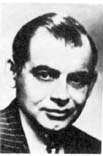Sylvan Byck
Sylvan Byck (July 17, 1904 in Otisville, New York - July 8, 1982 in Queens, New York)[1] (pronounced "bike")[2] was the comic strip editor for King Features Syndicate for over 30 years, in which position he evaluated "up to 2000 comics submissions a year."[3]

Early life
After graduating from the Pratt Institute, Byck worked for various newspapers, including as an editorial cartoonist at the Brooklyn Times-Union[1] and the Seattle Times.[4]
Career
In 1937, Byck joined King Features Syndicate, where he edited Pictorial Review;[1] during the Second World War, he served as "cable editor" for International News Service.[1] In 1945, he became King's comics editor.[1]
Among the multiple projects that he purchased were Mort Walker's Beetle Bailey (which he saved from cancellation by relaying to Walker the suggestion that the strip's college-student protagonist should join the United States Army)[5] and Hi and Lois,[6] for which Byck and Walker independently suggested recruiting Dik Browne as illustrator[7] (Browne later recalled that, when first contacted by Byck, he assumed that it was Stan Drake playing a prank).[7] As well, Byck suggested that Bob Weber produce a strip of his own; Weber subsequently created Moose Miller.[8] Other strips in whose launching he was "instrumental" included Buz Sawyer, Redeye, Hazel, Trudy, The Lockhorns, Inside Woody Allen, and the Archie comic strip.[9]
Byck was also responsible for ensuring the continuation of strips after their original creators were no longer available, including Little Iodine (where he arranged for Hy Eisman to succeed Bob Dunn — who was himself a successor to Jimmy Hatlo)[10] and Rip Kirby (where he tried to recruit Leonard Starr to succeed Alex Raymond in the wake of Raymond's sudden death; Starr suggested that Byck instead hire John Prentice).[11] However, in the case of Steve Canyon, Byck "dismissed the possibility of a successor" to the strip's creator Milt Caniff, on the grounds that Caniff "could never be imitated".[12]
In 1978, Byck retired, and was succeeded by Bill Yates (who Byck had recruited in 1960 as the creator of Professor Phumble).[13]
Praise
In 1977, Inklings Magazine (journal of the Museum of Cartoon Art) called Byck "the most influential man in newspaper comics in our generation",[9] and in 1979, the National Cartoonists Society awarded him the Silver T-Square Award.[14]
Mort Walker said that, of all the editors he met when he was beginning his career, Byck was "the most helpful and encouraging".[15]
Criticism
Alex Toth stated that, when he applied to be the new illustrator for the Perry Mason comic strip, Byck told him that he would be required to imitate Alex Raymond's style rather than use his own; Toth refused, and subsequently noted that if Raymond had "witnessed the absurd lengths to which (Byck went) in imposing (Raymond's) style on other talents, he would be Byck's most vociferous detractor".[16]
Stan Drake reported having been chastised by Byck for including too much emotional expression when drawing the faces of characters in The Heart of Juliet Jones.[17]
References
- Sylvan Byck, comic strips editor, dead at 78 at United Press International, published July 8, 1982, retrieved June 3, 2019
- "Are the funnies an art form", by Mike McLeod, in The San Bernardino County Sun, June 6, 1978, p 12
- Sylvan Byck, in the Daytona Beach Morning Journal, July 9, 1982, p 20
- "Great Cartoonists and Their Art", by Art Wood, published by Pelican Publishing, 1987
- Connecticut Cartoonists #7: Mort Walker, Dik Browne and Jerry Dumas, by Ron Goulart, in The Comics Journal; published July 26, 2016; retrieved June 4, 2019
- Mort Walker: Conversations, edited by Jason Whiton, published 2005 by University Press of Mississippi
- Funny Business: The Rise and Fall of Johnstone and Cushing, by Tom Heintje, originally published in Hogan's Alley #10, 2002
- MOOSE MILLER, at Don Markstein's Toonopedia; retrieved June 3, 2019
- Inklings (Spring 1977 issue), p 4, 12, 14-15
- "Jimmy Hatlo — Man of Many Hats", by Ed Black, originally published in Hogan's Alley #17 (2010)
- NCS Spotlight On: John Prentice, at the National Cartoonists Society; published August 26, 2010; retrieved June 3, 2019
- Meanwhile...: A Biography of Milton Caniff, Creator of Terry and the Pirates ..., by R. C. Harvey, published July 12, 2007 by Fantagraphics Books; "Byck would later pay Caniff the ultimate compliment: he dismissed the possibility of a successor to Caniff on 'Steve Canyon' by saying that Caniff could never be imitated."
- Cartoonist Bill Yates Dead at 79 Distinguished 10-Year Career as King Features Comics Editor, at King Features Syndicate; published March 27, 2001; retrieved June 3, 2019
- The Gold and Silver T-Squares, at the National Cartoonists Society; retrieved June 3, 2019
- Early Disappointment, by Brian Walker, at BeetleBailey.com; published May 14, 2015; retrieved June 3, 2019
- Setting the Standard: Comics by Alex Toth 1952–1954, published August 17, 2011, by Fantagraphics Books
- Alex Raymond's Last Ride, by Arlen Schumer; originally published in Hogan's Alley #3 (1994)